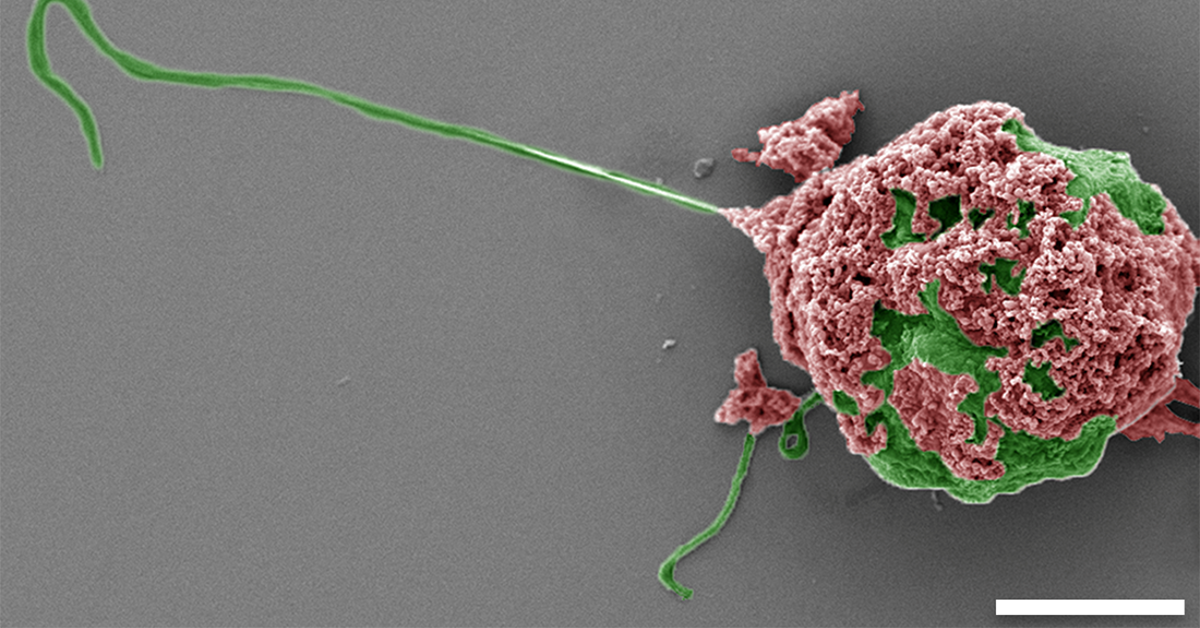Engineers at the University of California, San Diego, have developed a revolutionary approach to treating inflammatory bowel disease (IBD). Their innovation involves a pill that delivers microscopic robots, or microrobots, directly to the inflamed colon. This minimally invasive treatment has shown promising results in mice, significantly reducing IBD symptoms and promoting tissue repair without causing any adverse side effects. The study has been published in Science Robotics.
 Colored SEM image of a microrobot made of an algae cell (green) covered with macrophage-mimicking nanoparticles (red). Scale bar: 5 µm. Image Credit: Li et al, Science Robotics
Colored SEM image of a microrobot made of an algae cell (green) covered with macrophage-mimicking nanoparticles (red). Scale bar: 5 µm. Image Credit: Li et al, Science Robotics
Millions of people worldwide suffer from inflammatory bowel disease (IBD), an autoimmune disease marked by persistent inflammation of the gut that can cause severe abdominal pain, rectal bleeding, diarrhea, and weight loss. It happens when immune cells called macrophages become excessively activated and release high concentrations of pro-inflammatory cytokines, which are proteins that cause inflammation.
The debilitating symptoms of IBD are caused by a cycle of inflammation that is sustained by these cytokines binding to receptors on macrophages and causing them to produce more cytokines.
Currently, scientists have created a medication that effectively regulates these cytokine levels. Researchers at UC San Diego's Aiiso Yufeng Li Family Department of Chemical and Nano Engineering, Liangfang Zhang and Joseph Wang, led a team that created microrobots made of chemically attached inflammation-fighting nanoparticles to green algae cells.
In the stomach, the nanoparticles take up and neutralize pro-inflammatory cytokines. Meanwhile, the green algae quickly remove cytokines to aid in the healing of inflammatory tissue by effectively dispersing the nanoparticles throughout the colon using their innate ability to swim.
These nanoparticles’ biomimetic design gives remarkable efficacy and can function as macrophage spies. They are composed of biodegradable polymer nanoparticles coated in macrophage cell membranes. These decoys break the inflammatory cycle because they naturally bind pro-inflammatory cytokines without being stimulated to produce more.
The beauty of this approach is that it’s drug-free - we just leverage the natural cell membrane to absorb and neutralize pro-inflammatory cytokines.
Liangfang Zhang, Team Lead, Department of Chemical and Nano Engineering, UC San Diego
The scientists have made sure that the strict safety requirements are met by biohybrid microrobots. The US Food and Drug Administration has certified the green algae cells used in the study as safe for ingestion, and the nanoparticles are composed of biocompatible materials.
The microrobots are enclosed within a liquid capsule coated with a pH-responsive material. When stomach acid reaches the colon's neutral pH, the coating dissolves, but it stays intact in the stomach's acidic environment. This ensures that the microrobots are released selectively where they are most needed.
We can direct the microrobots to the diseased location without affecting other organs. In this way, we can minimize toxicity.
Joseph Wang, Team Lead, Department of Chemical and Nano Engineering, UC San Diego
The functionalized algae are held in the liquid phase by the capsule until they are released.
The capsule was administered orally to mice suffering from IBD. Without any noticeable side effects, the treatment reversed the weight loss caused by IBD, decreased colon inflammation, and decreased fecal bleeding. It also improved stool consistency.
The research group is currently concentrating on implementing its microrobot therapy in clinical trials. The authors contributed equally to this study, which is supported by the Defense Threat Reduction Agency Joint Science and Technology Office for Chemical and Biological Defense.
Journal Reference:
Li, Z., et al. (2024) Biohybrid microrobots regulate colonic cytokines and the epithelium barrier in inflammatory bowel disease. Science Robotics. doi.org/10.1126/scirobotics.adl2007